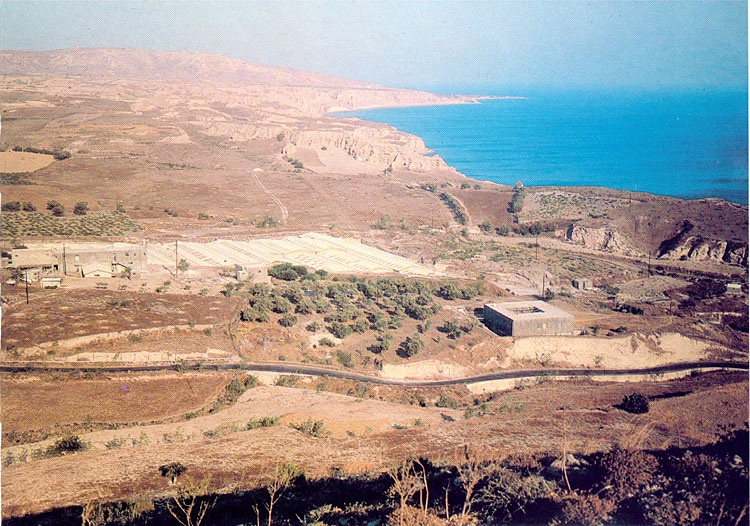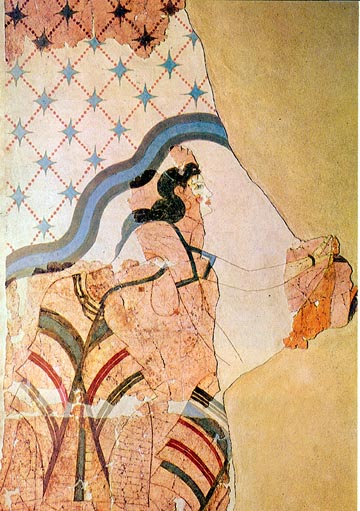|
Thera (Santorini): Painting
AKROTIRI
|

View of Akrotiri, Thera
Exacavation area under roofs in middle distance

View of the excavations, Akrotiri, Thera
To date, archeologists digging at Akrotiri have uncovered large portions of an
ancient town. The paved, winding streets and houses of stone and mud brick
reveal a high standard of living. Homes had basements for storage and workroom
space and upper-story living quarters. Mills attached to the houses indicate
an active farming as well as seafaring economy. Walls were reinforced with
timber and straw to protect against earthquakes. Interior baths and toilets
were connected by clay pipes to an extensive drainage and sewage system under
the streets. Such elaborate attention to comfortable living conditions is not
found again in the west until the rise of the Roman Empire over a thousand
years later.
Equally remarkable was the attention paid to works of art on Thera. The walls
of many private houses were decorated with frescoes, which indicates the
presence of a thriving artistic community. This unexpected discovery has
revealed an important new body of paintings. They represent a wide range of
subjects: landscapes, animals, human figures engaged in sports and rituals,
boats, and warriors.
When they were discovered, most of the frescoes were covered with volcanic ash which had to be carefully removed by brush. The paintings had fallen from the walls and had to be restored piece by piece to their original locations.
Theran pictures are characteristically framed at the top with painted borders,
often created by abstract geometric patterns. Numerous paintings have been
discovered and reconstructed.

Ship fresco
from Room 5 of the West House, Akrotiri
c. 1650-1600 BCE
(National Archaeological Museum, Athens)
One of the most significant painting discovered
on Thera is the large Ship fresco. It depicts a naval battle, city
walls, human figures, landscape, fish, and animals. A work such as this
documents the types of boats used by the ancient Therans and the sort of towns
they built as well as their style and technique of mural painting.

Landscape fresco
from Akrotiri, Thera
c. 1650-1600 BCE
(National Archaeological Museum, Athens)
One house in Akrotiri has a room entirely painted with flowers springing from
hillocks and with birds (swallows) flying above. These are the earliest pure
landscapes anywhere (although fragments suggests that there may have been
others like them in the palaces and villas on Crete itself.

Portrait of a Priestess
from Thera
LB I
(National Archaeological Museum, Athens)

Woman A
from House of the Ladies, Akrotiri, Thera
LB I
(Archaeological Museum, Thera)

Woman B
from House of the Ladies, Akrotiri, Thera
LB I
(Archaeological Museum, Thera)
|
© Christopher L. C. E. Witcombe
|

 SPRING 2016
SPRING 2016  SCHEDULE
SCHEDULE  REQUIREMENTS
REQUIREMENTS

 SPRING 2016
SPRING 2016  SCHEDULE
SCHEDULE  REQUIREMENTS
REQUIREMENTS